Anyone who has been stung by a black-tailed tiger hornet (Vespa basalis) would understand my immediate trepidation at stumbling on them while hiking Kaohsiung’s Weiliao Mountain (尾寮山). I’ve been stung a few times by these flying hypodermic needles, and the shock of pain lives up to their “murder hornet” moniker.
Should I try to navigate around them, or get the hell off the mountain?
NO 47 OF THE SMALL 100 PEAKS
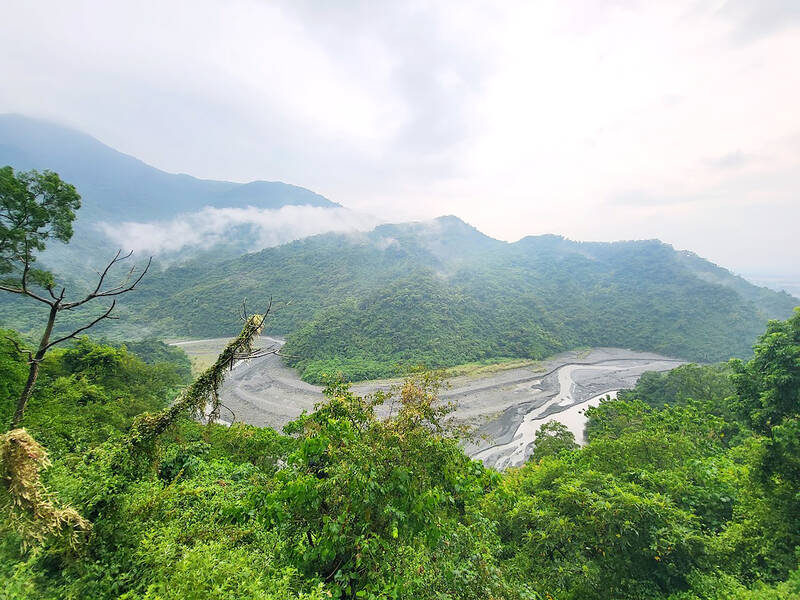
Photo: Mark Roche
Weiliao Mountain (1,427m) is No 49 of the xiaobaiyue (小百岳, “small 100 peaks”). I’d come here late last year to achieve a two-pronged ascent of the peak, breaching the trail on foot and bike from, respectively, the west and east.
I left Kaohsiung at 7pm for a night approach to the trail head, which took about three hours. Night riding may not appeal to some but, with a strong light, once out of the city the roads are quiet and in some ways safer than the day time.
I camped on the banks of the Jhuokou River (濁口溪) which was bliss on an October evening with only the sound of the river flow breaking the silence.

Photo: Mark Roche
HIKING WEILIAO MOUNTAIN
The following morning, I got an early start to the foot of the hike at an elevation of just over 200m. The trail starts out as broken concrete, but it isn’t long before the road dissipates and the trail turns to dirt.
Situated at the 0km marker on County Road No 185 it’s impossible to get lost as there is usually a line of cars parked along the road close to the trailhead. But there is rarely a traffic jam of hikers since most will be fairly well spread out along the 9km route.
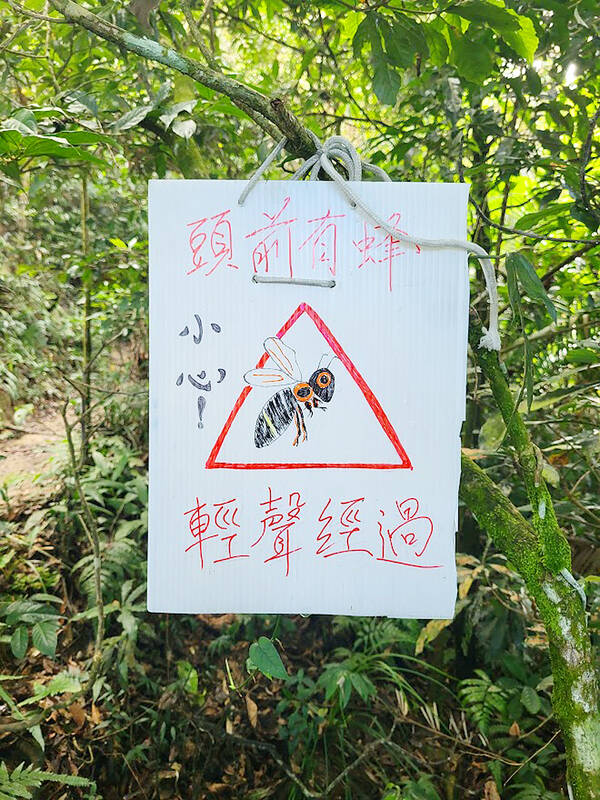
Photo: Mark Roche
After about 2 hours of hiking, there is a gazebo that offers a spectacular view of the Laonong (荖濃溪) and Jhuokuo rivers, which converge in the valley below. It’s an ideal half-way rest point.
The mountain is well known for its dense forest and biodiversity. I saw a Formosan Muntjac, commonly called “barking deer” because of the dog-like bark they emit.
Apart from a few look-out points, the views are mostly obscured by the forest. However, this presents a much better chance of encountering wildlife — though not always of the friendly kind.
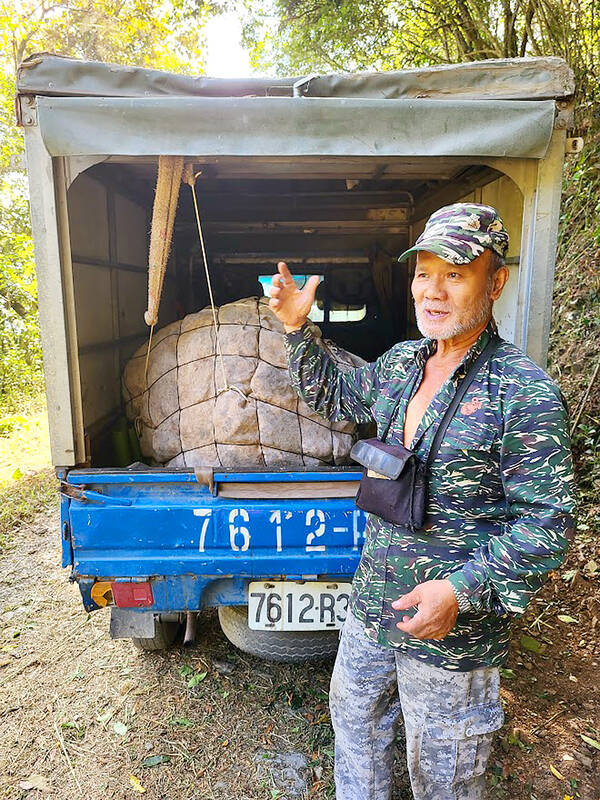
Photo: Mark Roche
THE HORNETS
After three and a half hours, I was approaching the summit on the steepest part of the trail when I noticed two signs warning of the presence of the hornets. The annual season for hornets is from August to January, so it’s unlikely you’ll encounter them now. But if encountered, it’s wise to turn around as they have been known to cause fatalities such is their ferocious nature and the toxicity of their venom.
I was tempted to turn around when I saw a swarm of them on the ground. The scariest thing about these hornets is that they release pheromones when they are hurt or killed. The chemical alerts other wasps to attack. Fortunately, I was able to navigate a path around without stirring them up.
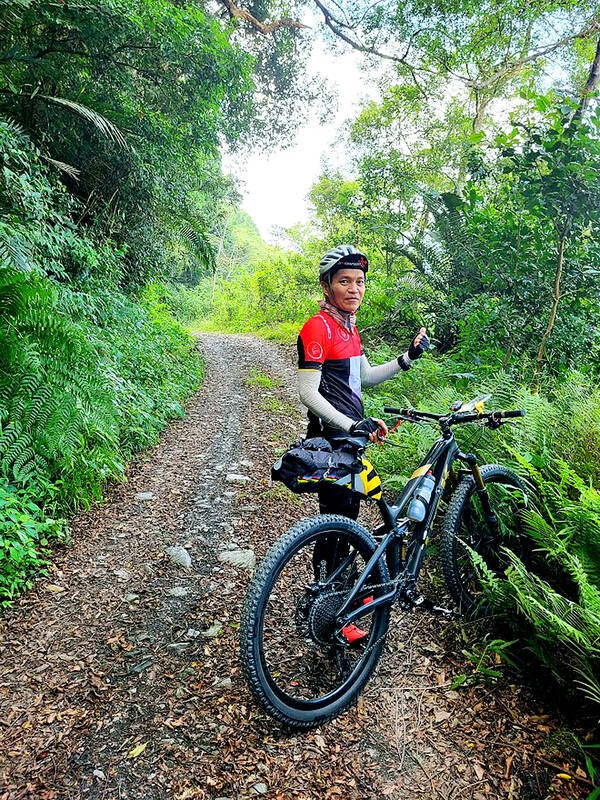
Photo: Mark Roche
After a short break at the summit I noticed the trail going down the other side and realized that this is part of the east approach. Curiosity got the better of me and I couldn’t resist the temptation to explore.
This ended up being a mistake. After 4km on trail going downhill I was now 23km away from the entrance at the other end. I could have backtracked, but clouds were rolling in and I decided to proceed. I soon discovered that I was on the Shaxi Forestry Road (沙溪林道), which is a popular mountain bike route.
It was nearly 5pm by the time I got back to my bike at the west entrance to the trail, so another night was spent at the camp site since I just didn’t have the energy to ride home.

Photo: Mark Roche
BIKING WEILIAO MOUNTAIN
A few weeks later, I mountain biked from the east. In former years the Shaxi Forestry Road was one of the most popular mountain bike routes in southern Taiwan. More recently it seems to have been left to nature and in some parts it’s not always clear that a road ever existed. The starting point is at the 14km marker on County Road No 185.
After several kilometers of concrete, the road turns to dirt and is a joyful meander up the mountain. Unlike the west approach, the east is completely exposed offering spectacular views of the surrounding mountains to the south and east.
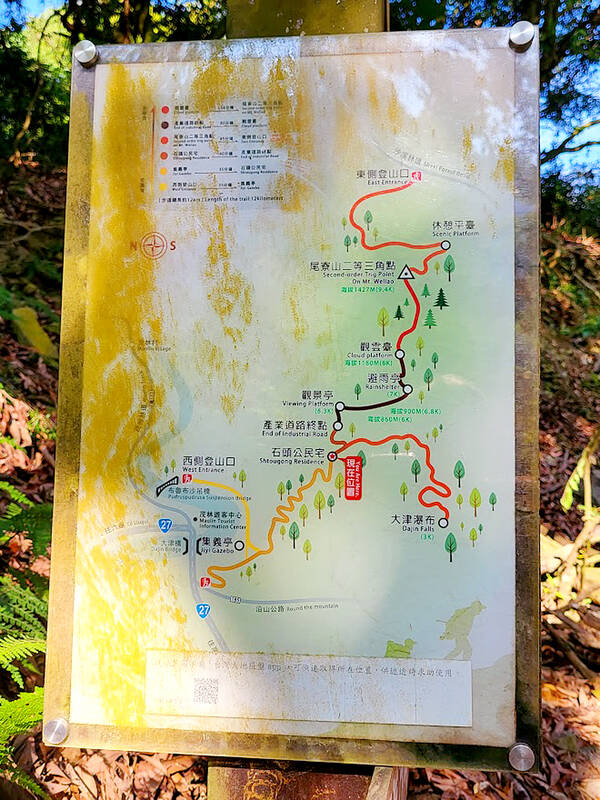
Photo: Mark Roche
On the way up I saw a farmers’ blue truck parked on the side of the road. When I approached he asked if I was going up Weiliao Mountain.
“Be careful of the hornets,” he said to me as he unveiled a massive bundle he had wrapped in netting and stuffed into the back of his blue truck.
He said he had been commissioned to remove a hive of black-tailed tiger hornets and had just finished the task. It weighed over 20kg and was several times the size of a regular bee hive.
Although I made it as far as I could go on the bike, evidence of bees in the area resulted in me not attempting the 2km left of the hike to the peak of Weiliao Mountain. There’s always another time.

US President Donald Trump may have hoped for an impromptu talk with his old friend Kim Jong-un during a recent trip to Asia, but analysts say the increasingly emboldened North Korean despot had few good reasons to join the photo-op. Trump sent repeated overtures to Kim during his barnstorming tour of Asia, saying he was “100 percent” open to a meeting and even bucking decades of US policy by conceding that North Korea was “sort of a nuclear power.” But Pyongyang kept mum on the invitation, instead firing off missiles and sending its foreign minister to Russia and Belarus, with whom it

When Taiwan was battered by storms this summer, the only crumb of comfort I could take was knowing that some advice I’d drafted several weeks earlier had been correct. Regarding the Southern Cross-Island Highway (南橫公路), a spectacular high-elevation route connecting Taiwan’s southwest with the country’s southeast, I’d written: “The precarious existence of this road cannot be overstated; those hoping to drive or ride all the way across should have a backup plan.” As this article was going to press, the middle section of the highway, between Meishankou (梅山口) in Kaohsiung and Siangyang (向陽) in Taitung County, was still closed to outsiders

Many people noticed the flood of pro-China propaganda across a number of venues in recent weeks that looks like a coordinated assault on US Taiwan policy. It does look like an effort intended to influence the US before the meeting between US President Donald Trump and Chinese dictator Xi Jinping (習近平) over the weekend. Jennifer Kavanagh’s piece in the New York Times in September appears to be the opening strike of the current campaign. She followed up last week in the Lowy Interpreter, blaming the US for causing the PRC to escalate in the Philippines and Taiwan, saying that as

The Chinese Communist Party (CCP) has a dystopian, radical and dangerous conception of itself. Few are aware of this very fundamental difference between how they view power and how the rest of the world does. Even those of us who have lived in China sometimes fall back into the trap of viewing it through the lens of the power relationships common throughout the rest of the world, instead of understanding the CCP as it conceives of itself. Broadly speaking, the concepts of the people, race, culture, civilization, nation, government and religion are separate, though often overlapping and intertwined. A government